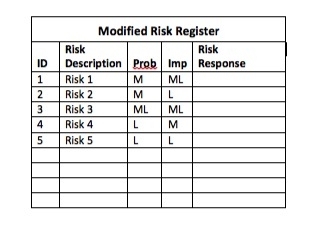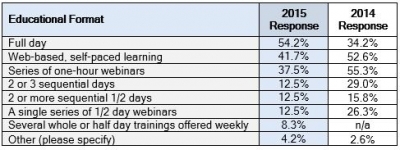New courses in response to marketplace demand include:
New and aspiring leaders will benefit from our Handling Employee Performance Problems and Termination, Business Communications and Team Performance (which is also offered for experienced managers.) Visit a complete list of courses or download the catalog here. Our annual training needs survey (again) demonstrated the highest interest in courses that increase proficiency in leadership, strategy and management – even among Project Managers. We have a robust selection of these courses from Fundamentals of Leadership to advanced topics, such as 360-Degree Leadership.
 Our project management courses have been updated to align with the 6th edition of the Project Management Body of Knowledge (PMBOK®) guide. Every course description in the catalog includes a listing of the number of credits by organization. See inset for example of accreditations per course.
Our project management courses have been updated to align with the 6th edition of the Project Management Body of Knowledge (PMBOK®) guide. Every course description in the catalog includes a listing of the number of credits by organization. See inset for example of accreditations per course.Need help bringing training to your organization?
Thousands of studies have been conducted that validate the connection between investing in employee training and development and the increase in loyalty, morale, and retention. Lower turnover reduces costs and prevents unanticipated gaps in performance. Most important, high morale and a loyal staff translates into more satisfied customers and a better bottom line. And after all, aren’t satisfied customers what keeps your organization in the black?!
Our facilitators are expert at tailoring course(s) to the needs and experience levels of your staff. Find out how, by contacting Jim Wynne, for a no obligation discussion at jwynne@meritcd.com or 610-225-0449.
FREE Tips
Check out our LinkedIn Friday Facts. These nuggets are excerpts from our courses that people enjoy sharing with their friends and colleagues. It will be worth your time.
 Previously, we wrote about how resolving conflict often has the side benefit of building a cooperative bond — even loyalty — between the factions. As each side gains a deeper understanding of the others’ viewpoints, respect builds and morale improves. Cooperative, low stress interactions, create a fertile environment for productive brainstorming, ultimately boosting the health of your organization.
Previously, we wrote about how resolving conflict often has the side benefit of building a cooperative bond — even loyalty — between the factions. As each side gains a deeper understanding of the others’ viewpoints, respect builds and morale improves. Cooperative, low stress interactions, create a fertile environment for productive brainstorming, ultimately boosting the health of your organization. In Part 3 of this series, we’ll examine the five conflict styles that help people understand their own responses as well as diffuse conflict with others. Specifically, we’ll look at the five conflict styles that Kenneth W. Thomas and Ralph H. Kilmann identified and can be assessed in the Thomas-Kilmann Conflict Mode Instrument (TKI), a globally accepted, widely used diagnostic assessment for resolving conflict.
In Part 3 of this series, we’ll examine the five conflict styles that help people understand their own responses as well as diffuse conflict with others. Specifically, we’ll look at the five conflict styles that Kenneth W. Thomas and Ralph H. Kilmann identified and can be assessed in the Thomas-Kilmann Conflict Mode Instrument (TKI), a globally accepted, widely used diagnostic assessment for resolving conflict. I aspired to broaden my career and went back to school for a Masters in Leadership Development about 12 years ago. Through a confluence of introductions, opportunities and also being an adjunct instructor at Drexel University, I joined one of my cohort’s businesses, Merit Career Development. Initially, I began helping them with a new branding initiative, but in an “Ah Ha” moment we realized that I’d likely be a strong trainer for Merit, too. We were right. I have been running corporate trainings for Merit now for five years and I love it! But here’s the surprise: one of my favorite courses to facilitate, is Conflict Management (followed closely by Critical Thinking & Decision-Making.)
I aspired to broaden my career and went back to school for a Masters in Leadership Development about 12 years ago. Through a confluence of introductions, opportunities and also being an adjunct instructor at Drexel University, I joined one of my cohort’s businesses, Merit Career Development. Initially, I began helping them with a new branding initiative, but in an “Ah Ha” moment we realized that I’d likely be a strong trainer for Merit, too. We were right. I have been running corporate trainings for Merit now for five years and I love it! But here’s the surprise: one of my favorite courses to facilitate, is Conflict Management (followed closely by Critical Thinking & Decision-Making.) Through a confluence of circumstances, that began with an invitation from the Keystone PMI Education Foundation Coordinator, Mr. Myles Miller, and the Keystone Chapter of the Project Management Institute, we supported a pilot with 6th graders at the Eyer Middle School in Pennsylvania’s North Penn School District. The parents and students were quite interested in learning the life skill of project management. While some of us were doubtful that our workplace-related program would resonate with these young students, we had enough people willing to give this a try that we scheduled the program. (
Through a confluence of circumstances, that began with an invitation from the Keystone PMI Education Foundation Coordinator, Mr. Myles Miller, and the Keystone Chapter of the Project Management Institute, we supported a pilot with 6th graders at the Eyer Middle School in Pennsylvania’s North Penn School District. The parents and students were quite interested in learning the life skill of project management. While some of us were doubtful that our workplace-related program would resonate with these young students, we had enough people willing to give this a try that we scheduled the program. ( The simulation project management competition also generated interest from many families whose children did not have the opportunity to participate the first time this was held, prompting a follow up event scheduled for Spring, 2017. Because the interest is so high, the school is planning to make SimulTrain a regular part of the Eyer Middle School curriculum. A number of universities are also interested in adding project management with simulation to their curriculum. The University of Scranton recently held a competition among their engineering students. There is a similar day scheduled at Lehigh University next month.
The simulation project management competition also generated interest from many families whose children did not have the opportunity to participate the first time this was held, prompting a follow up event scheduled for Spring, 2017. Because the interest is so high, the school is planning to make SimulTrain a regular part of the Eyer Middle School curriculum. A number of universities are also interested in adding project management with simulation to their curriculum. The University of Scranton recently held a competition among their engineering students. There is a similar day scheduled at Lehigh University next month.
 As the image to the left illustrates, participatory learning, especially using simulation for practice, provides the highest level of retention for training, second only to “teaching others.”
As the image to the left illustrates, participatory learning, especially using simulation for practice, provides the highest level of retention for training, second only to “teaching others.” Standard risk responses include Avoidance, Mitigation, Transference, and Acceptance (passive/active). At Merit, we developed a reporting process that would show that the risk factors were decreasing as the project progressed. Supplemented with suitable risk responses, the true reduction of risk probability occurs over time.
Standard risk responses include Avoidance, Mitigation, Transference, and Acceptance (passive/active). At Merit, we developed a reporting process that would show that the risk factors were decreasing as the project progressed. Supplemented with suitable risk responses, the true reduction of risk probability occurs over time. The Probability and Impact Matrix is one of the tools that we recommend in a risk management strategy. It is superimposed with risks that are labeled or numbered as in the above example. “Red” area risks were uniquely documented on a trending month-to-month basis such that it could be seen “driving” toward zero.
The Probability and Impact Matrix is one of the tools that we recommend in a risk management strategy. It is superimposed with risks that are labeled or numbered as in the above example. “Red” area risks were uniquely documented on a trending month-to-month basis such that it could be seen “driving” toward zero. Studies show that lack of EQ may limit a person’s ability to achieve results. Lower EQ scores correlate with lower merit pay increases, lower job satisfaction and more burnout. Managers’ and supervisors’ EQ scores correlate with their performance ratings.
Studies show that lack of EQ may limit a person’s ability to achieve results. Lower EQ scores correlate with lower merit pay increases, lower job satisfaction and more burnout. Managers’ and supervisors’ EQ scores correlate with their performance ratings. We all have specific words or phrases that are steeped in emotion. During the 1960s and 70s, the term “nuclear power” raised a great deal of emotion—both positive and negative. Similarly today we have emotionally charged words or phrases such as “gun control”, terrorism, and consumer privacy. It is important to recognize one’s own emotionally charged phrases and stop the emotional hijacking that is about to take place.
We all have specific words or phrases that are steeped in emotion. During the 1960s and 70s, the term “nuclear power” raised a great deal of emotion—both positive and negative. Similarly today we have emotionally charged words or phrases such as “gun control”, terrorism, and consumer privacy. It is important to recognize one’s own emotionally charged phrases and stop the emotional hijacking that is about to take place.

 The basis for choosing a course and provider were measured differently last year, but in both instances, the primary driver is the course topic and/or area that most needs development, followed by convenience of timing, and location. The program cost was lower in priority. See Q3 chart on the left for details.
The basis for choosing a course and provider were measured differently last year, but in both instances, the primary driver is the course topic and/or area that most needs development, followed by convenience of timing, and location. The program cost was lower in priority. See Q3 chart on the left for details. Even the most carefully planned project can run into trouble. Unanticipated weather problems can disrupt the logistics of construction projects, a key software developer quits to take new jobs or an engineer underestimates the time needed to implement components of a production line. Whatever the issue, the challenge of finding a solution falls to the project manager (PM).
Even the most carefully planned project can run into trouble. Unanticipated weather problems can disrupt the logistics of construction projects, a key software developer quits to take new jobs or an engineer underestimates the time needed to implement components of a production line. Whatever the issue, the challenge of finding a solution falls to the project manager (PM).